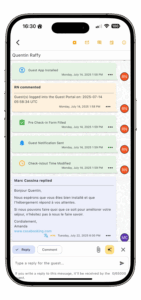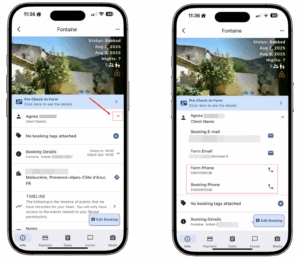Preparing for Guest Arrivals: Our Communication Protocol
At CasaBooking, we are committed to providing guests with a smooth, stress-free experience — and that starts long before check-in. Clear, timely, and personalized communication is essential to ensure everything goes as planned.
To maintain this standard, we’ve put in place a structured communication protocol. Here’s how it works — and how you, as a host, can play an active role
Accessing Guest Conversations
All automatic and manual messages sent to guests are visible within each booking file under the Inbox / Forum tab.
If you notice any incorrect information or would like to suggest improvements, simply leave a comment in that same forum. Only the CasaBooking team will see it — guests do not have access



A Structured Communication Timeline
We follow a clear timeline to ensure nothing is forgotten and guests feel well-informed throughout the process:
10 Days Before Arrival
- Guests receive a pre check-in request, where they are asked to confirm their expected arrival time, the number of adults and children, etc.
- Once completed, they receive a reminder with the name and phone number of their on-site contact (owner or concierge), inviting them to get in touch if they need bed linens, towels, a baby crib, etc., and to confirm their estimated arrival time.
6 Days Before Arrival
- First reminder sent to guests who haven’t completed the pre check-in
4 Days Before Arrival
- Second reminder sent to those still pending



Direct Follow-Up If Needed
Starting 7 days before arrival, if you haven’t heard directly from the guest, we recommend sending a SMS or WhatsApp message to establish contact.
By Day -3, if there’s still no response, it’s important to try again — they haven’t replied to our three reminders, and may not have received them.
If there’s still no reply within 24 hours, please notify us so we can step in

Example Message for Guests
Message in French:
Subject: Votre arrivée à CASA XXX dans N jours !
Bonjour [FIRST_NAME],
Votre arrivée à CASA XXX approche à grands pas, plus que N jours !
Merci de me communiquer votre heure d’arrivée estimée dès que possible, et de me préciser si vous avez des demandes particulières (animal de compagnie, lit bébé…).
Besoin de draps et serviettes ?
Merci de passer commande avant [jeudi/demain…] pour que la blanchisserie puisse nous les fournir à temps.
Solde à régler ?
Si un paiement est dû, merci de prévoir du liquide à l’arrivée (cela m’évitera un aller-retour le lendemain !).
Une question ?
Contactez-moi de préférence par SMS pour une réponse rapide.
À très bientôt à XXX !
Cordialement,
YYY
Message in English:
Subject: Your Arrival at CASA XXX in N Days!
Hello [FIRST_NAME],
Your arrival at CASA XXX is just N days away!
Please let me know your estimated arrival time as soon as possible, and share any special requests (pet, baby crib, etc.).
Need linens and towels?
If so, please request them by [Thursday/tomorrow…] so the laundry service can deliver them on time.
Outstanding payment?
If any balance is due, please bring cash upon arrival (this avoids a second trip the next day!).
Any questions?
Feel free to contact me by SMS for a quicker response.
Looking forward to welcoming you to XXX!
Best regards,
YYY
A Clear Protocol = Better Guest Experience
This protocol is designed to anticipate guest needs, streamline arrival planning, and ensure a smooth welcome — all while making your day-to-day management more efficient and stress-free.
Well-prepared guests are happy guests, and a smooth check-in starts with clear communication.
The peace of mind you deserve
Join CasaBooking and let us make your property a successful, worry-free investment!